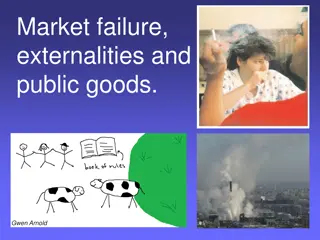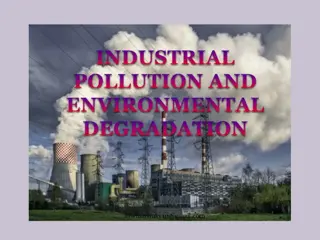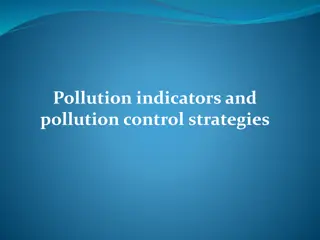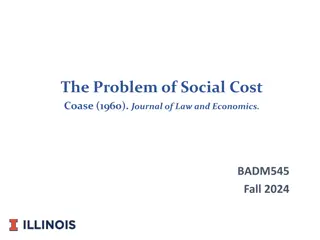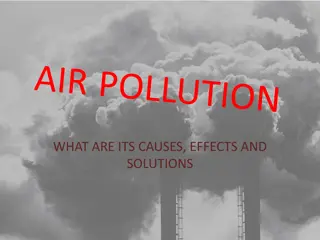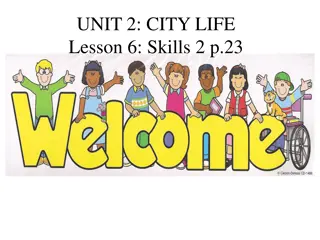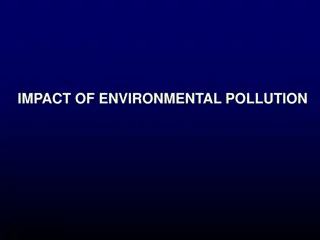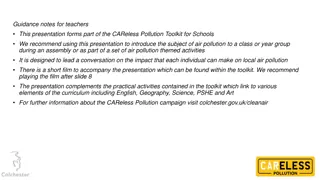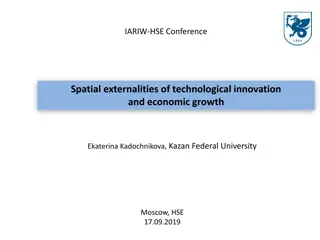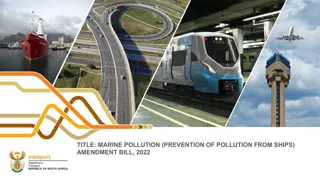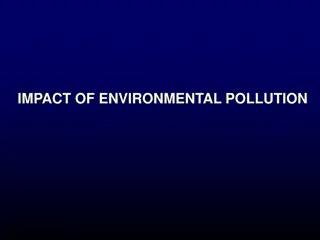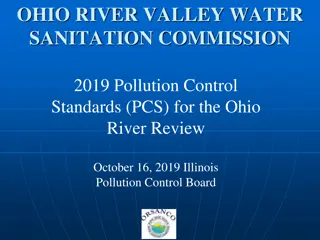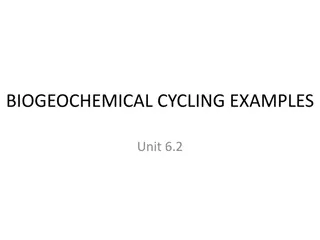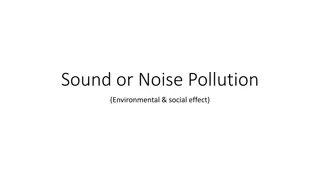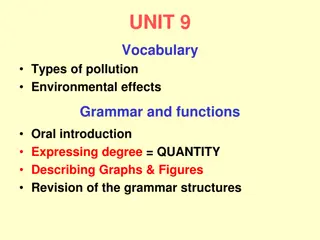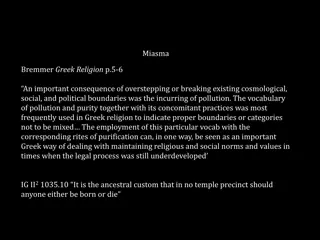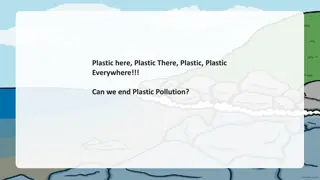Strategies to Address Pollution and Negative Externalities
Exploring the concept of negative externalities, the text discusses how markets interact to allocate resources and the ethical considerations involved in balancing economic activities with pollution reduction. It presents three effective ways to mitigate negative externalities, such as command and control regulations, taxation policies, and property rights with bargaining, emphasizing the importance of collective responsibility in reducing pollution.
Download Presentation

Please find below an Image/Link to download the presentation.
The content on the website is provided AS IS for your information and personal use only. It may not be sold, licensed, or shared on other websites without obtaining consent from the author. Download presentation by click this link. If you encounter any issues during the download, it is possible that the publisher has removed the file from their server.
E N D
Presentation Transcript
What Can We Do About Pollution?
Vocabulary Externalities are the costs and benefits of someone s choice that spill over to a third party who is not involved in the transaction. Negative externalities are when the choice to produce or consume a good results in a cost to that third party. 2
Vocabulary Markets are the interaction between buyers and sellers for the purpose of exchanging goods and services. Markets help people allocate: that is, to choose what to produce, how much to produce, and to decide who consumes what is produced. Market interactions create market prices, which are signals that help allocate scarce goods and services. Market prices are for the economy what traffic signals are for traffic: they coordinate the actions of many people. 3
Ethical concerns This lesson focuses on outcomes-based ethics: a moral philosophy that discerns right or wrong action based on the consequences produced by the action. In the lesson, we assume that both producing goods and services and reducing pollution are good goals, and seek the best way to achieve them. 4
Three ways to reduce negative externalities 1. Command and control: Government (or other authority) makes rules limiting the externality. Examples: City governments do not allow people to pour motor oil down storm drains, since the oil pollutes waterways, harming people and wildlife. Teachers do not allow students to run in the hallways, since it is dangerous and annoying for other students. 5
Three ways to reduce negative externalities 2. Taxes: Government charges a fee on anyone creating the externality. The tax can be high enough that no one wants to do the externality, or it can be lower so that some externality is allowed. Examples: Local governments issue parking tickets for illegally parked vehicles, to allocate parking space. Government taxes cigarettes to discourage people from smoking, since second-hand smoke is annoying and can harm other people s health. 6
Three ways to reduce negative externalities 3. Property rights plus bargaining: assigning clear liability, responsibility, or property right to people who can reduce the externality. Then providing a way to sell, trade, or take responsibility for the externality. Examples: You ask your neighbors to turn their loud, irritating music down. They agree to turn it down by 10pm since it s a weekend. You agree. Governments set a limit on the amount of air pollution that is acceptable. Then they give pollution permits to producers who are potential polluters. The producers may exchange these permits with each other in a market. This allows producers to maximize production while still limiting pollution. Restaurant employees sometimes steal from their employers by not ringing up transactions. Restaurants are liable for this. But some restaurants induce customers to take some responsibility for stopping theft by offering customers free meals if they aren't given a receipt. This forces employees to ring up sales. 7
The Guess the Word Game! - Overview 1. The goal of the game: guess ( produce ) the most words. Each team gets one dollar for each word produced. 2. Additional goal is to keep the noise level down - noise is an externality imposed on others! 3. You will be divided into teams of 3-4. Choose a teammate to be that round s leader. The leader draws a card from the stack and acts out the word or provides verbal clues to help teammates guess the word on the card. You may skip a card if it is too difficult, and draw a new one. 8
The Guess the Word Game! - Overview 4. When the team guesses the word correctly, the leader gives them a thumbs-up, draws a new word, and the team repeats the process until time is up. Put the guessed words in a separate pile. 5. Record how many words you guessed correctly in the time allotted. 6. There will be a student regulator assigned to oversee two to three teams. 7. We will produce words for two minutes per round, broken up into one-minute segments. 9
Visual 13.1: Production and Pollution Round 1 (C&C) Round 2 (T) Round 3 (PR+B) Minute 1 Decibels 50 (example) Minute 2 Decibels 70 (example) Minutes 1 + 2 decibel average 60 (average - example) # Produced ($) 15 words (example) 10
The Guess the Word Game! - Noisy Strategy 1. The Noisy Strategy: both the leader and the other teammates may talk - even shout! as they try to produce the words. They may gesture. But they are not allowed to say the bold-faced word or parts of the word. They also may not use the other words or parts of words printed on the card. They also may not say rhymes with If they do, they must discard the word and pick a new one. 2. This is like Taboo - who has played and will help demonstrate? 3. We will record our noise level with a decibel meter. 11
The Guess the Word Game! - Quiet Strategy 1. The Quiet Strategy: the leader must act out the bold-faced word from the card. The team tries to guess the word without talking. That is, they must write their guesses on sheets of paper and show them to the leader. (Ignore the non-bold-faced words on the card: those are for the Noisy Strategy of the game, described above.) 2. This is like Charades - who has played and will help demonstrate? 3. We will record our noise level with a decibel meter. 12
The Guess the Word Game! Round 1 Round 1: Two minutes One minute of Noisy Strategy One minute of Quiet Strategy Get in your teams and choose your leader Record the number you produce with each strategy At the end of the round, student regulators will pay you one dollar for each word produced 13
Round 1 Debrief How many words did your team produce using the The Noisy Strategy? Quiet Strategy? Total? How is guessing words similar to producing something in an economy? How is loud noise similar to pollution? Did you have any choice about when you were noisy or quiet? What strategy for reducing pollution was this? If a teacher wanted a nice, quiet classroom, would the Noisy Strategy have created a harmful externality? What was the tradeoff between the Noisy Strategy and the Quiet Strategy? 14
The Guess the Word Game! Round 2 You can pay a tax to the government (the teacher) that gives you the right to pollute with noise. Cost is $2 per one minute for the right to use the Noisy Strategy. You may buy 0, 1, or 2 one-minute periods of Noisy Strategy. Teams must have the money to pay the tax and must select their strategy for Round 2 now. Pay your student regulators for the number of minutes of Noisy Strategy you have selected. 15
The Guess the Word Game! Round 2 Student regulators will enforce your choices. You many change leaders for the round. Let s play! If you paid the tax you must use the Noisy time first. We will again record the decibel level. Student regulators pay each team for the number of words produced. 16
Round 2 Debrief How many words did you produce? Did you have any choice about when you were noisy or quiet? What strategy for reducing pollution did we use in this round? Did any team choose to pay the tax to be Noisy for both minutes of the round? If so, was it worth it? Did any team choose to keep their dollars, not pay for the right to be noisy, and participate with only the Quiet Strategy? Was it worth it? Did any team choose to pay the tax for one minute of Noisy and use Quiet for the other minute? Was it worth it? How noisy was the room? Did the tax reduce pollution much? Does this mean the tax was too high was too low? 17
The Guess the Word Game! Round 3 Permit Trading Round: You have been given one Noise Permit. Each one allows you to be noisy for one minute. You may buy or sell Noise Permits to anyone in the class at the price you negotiate and agree upon. You have three minutes to make trades in the Noise Permit market. Record the Permit price you agreed on! Give any Noise Permits you have to your student regulator who will enforce the appropriate strategy in the Round. You can change leaders again if you like. Let s play! If you purchased the Noise Permits you must use that time first. We will again record the decibel level. Student regulators pay each team for the number of words produced. 18
Round 3 Debrief Ask each team how many words they produced in Round 3. Did you have any choice about when you were noisy or quiet? What strategy for reducing pollution did we use in this round? With a show of hands: Which teams bought permits? Which teams sold permits? What did you pay for the permits? Why did some teams value the permits higher than others? Why did some teams value the dollars higher? 19
Round 3 Debrief Did you pick the right number of permits? Why or why not? Did the externality permits allow you to choose how much overall pollution there was? What was the benefit of allowing people to trade for the right to pollute? How could we reduce the overall noise pollution in this last round? How would this affect the teams and price of the Noise Permits? 20
Property rights plus bargaining (PR+B) Shows that externalities can be defeated if clear property rights (or liability) can be established. If there is clear property rights or liability established, then the externality can be limited by negotiation, like we saw in Round 3 of the game. Problems with this approach: It can be very difficult to establish the property right. Vague property rights are usually the original reason why the externality exists. Sometimes it is not easy for people to bargain for practical reasons. Obstacles to bargaining are called transaction costs. In the game, the bargaining itself caused noise! This is a transaction cost. 21
Three ways to reduce negative externalities Command and control ( C&C ): Government (or other authority) makes rules limiting the externality. Taxes ( T ): Government charges a fee on anyone creating the externality. The tax can be high enough that no one wants to do the externality, or it can be lower so that some externality is allowed. Property rights plus bargaining ( PR+B ): assigning clear liability, responsibility, or property right to people who are in a position to reduce the externality. Then providing a way to sell, exchange, or trade the responsibility for the externality. 22
Thinking about our game and three ways to reduce externalities: Which of the three versions of the game was best for producing words? Which of the three versions of the game was best for reaching the goal of of quiet classroom and overall limiting noise? How was guessing words similar to or a metaphor for producing goods and services? Was noise a good metaphor for a pollution externality? Why or why not? What can society do if someone s behavior is putting a burden on others? 23
Each method is has its uses Command and control For when people just want simple, clear rules. Taxation when For when transaction costs are high Government needs to raise revenue Property rights plus bargaining To reduce externalities efficiently To find how much people really value reducing an externality To reduce externalities without too much government intervention 24


